Anthropometric aspects and effects of exercise on hemodynamic, metabolic and weight in karate athletes
Keywords:
Karate, hemodynamic changes, metabolics, antropometricsAbstract
There are multiple physiopathological causes in which the physical activity is involved to counterattack the risk of disease; therefore it is important that the medical student knows about the physiological effects of exercise, because these aren’t pharmacologist’s measures that improve the quality of life of patients. The objective was to determine the immediate effects of exercise on hemodynamic, methabolic and anthropometric parameters in karate athletes. It was designed a prospective longitudinal descriptive study; the sample was composed of 27 athletes. the mentioned parameters were measured before starting the exercise and after an hour of physical activity. It was found a predominance of males(59,3%), the average age was 16,97 ± 8,0 years old. The average fat percentage was 7,90 ± 6,9. In relation to waist size 40,7% were obese. In terms of body mass index 11.1% were overweight. It showed a significant statistical difference in weight, heart rate, respiratory rate and diastolic blood pressure ((p = 0,0001; p = 0,001; p= 0,001 y p = 0,04 respectively). Even though in blood glucose levels, in systolic blood pressure, and The oxygen saturation were observed differences between the averages before and after exercise, there weren’t statistically significant. It was concluded that exercise has immediate effects on heart and respiratory rate, diastolic blood pressure as well as weight.
Downloads
References
2. Pancorbo, A., Pancorbo, E. Actividad física en la prevención y tratamiento de la enfermedad cardiometabolica. La dosis del ejercicio cardiosaludable. [libro en línea]. Madrid: International Marketing and Communication. Recuperado en http://www.google.co.ve/url?sa=t&rct=j&q=&esrc=s&source=web&cd=1&cts=1331431629782&sqi=2&ved=0CCEQFjAA&url=http%3A%2F%2Fwww.fundadeps.org%2Fdownload.asp%3Ffile%3Drecursos%2Fdocumentos%2F267%2Flibro_ejercicio_cardiosaludable_CSD.pdf&ei=bgVcT8enMKLz0gHcj8HVDw&usg=AFQjCNEBSq-rkZdHw_v7rP9ICv2CM_YXWg&sig2=QenKd9-pxJhU0aHASZboLg [citado 20-02-2012]
3. Firman, G. Fisiología del ejercicio físico. [Articulo en línea] Argentina: Intermedicina. Recuperado en http://www.intermedicina.com/Avances/Interes_General/AIG05.html [citado 20-02-2012]
4. González, L. Clasificación del sobrepeso y la obesidad. [Articulo en línea] Coruña: Meiga. Recuperado en http://www.meiga.info/Escalas/Obesidad.pdf
5. Haramboure, R. (2003) Fundamentos Fisio-metodologicos del Desarrollo de Capacidades en el Karate-Do. Efdeportes,9(65),[Revista Digital]. Buenos Aires: efdeportes. Recuperado en http://www.efdeportes.com/efd65/karate.htm [citado 5-3-2012]
6. Joaquin, H. (2008). Rendimiento funcional aerobio-anaerobio de ciclistas dominicanos de alto rendimiento .Republica Dominicana: Portales Médicos. Recuperado en http://www.portalesmedicos.com/publicaciones/articles/869/2/Rendimiento-funcional-aerobio-anaerobio-de-ciclistas-dominicanos-de-alto-rendimiento [citado 25-02-2012]
7. Padilla, J.(2001) Estudio comparativo de la fisiología del ejercicio en grupos de deportistas mexicanas de diferentes especialidades. Instituto Nacional de Enfermedades Respiratorias, [en línea] 14(3), 145-150. Recuperado en http://www.medigraphic.com/pdfs/iner/in-2001/in013b.pdf [citado 25-02-2012]
8. Thompson, L.(2002) The Physiological Effects of Endurance Events.Western:Curtyn University. Recuperado en: http://physiotherapy.curtin.edu.au/resources/educational-resources/exphys/00/endurance.cfm [citado 3-03-2012]
9. Ortega, R. (1992) Medicina del ejercicio físico y del deporte para la atención a la salud. [ en línea] Madrid: Díaz de Santos. Recuperado en http://books.google.co.ve/books?id=VHLaCDRxxQAC&pg=PA340&lpg=PA340&dq=aumento+de+la+glucemia+durante+el+ejercicio&source=bl&ots=Ib61Ke6zco&sig=GZfgIwXNp5t25oVv138OwSJIfPI&hl=es&sa=X&ei=EMdaT-zLCYPu0gGDk6WNBw&ved=0CCEQ6AEwAA#v=onepage&q&f=false [citado 5-03-2012]
10. Huertas, G., de los Santos, H., Berasain, D., Cabrera, C. (2008) Estudio Antropométrico De La Elite Sudamericana Juvenil De Karate. [trabajo en línea] Recuperado en http://www.gbmoim.com/wp-content/uploads/2008/01/antropometria-en-karate-juvenil.pdf [citado 5-3-2012]
11. Garrido, R., González, M., Expósito I. (2005) Patrones de Desaturación Ergoespirométricos en Jugadores de Baloncesto. G-SE Standard. Recuperado en http://www.g-se.com/pid/464/[citado 5-3-2012]
Published
How to Cite
Issue
Section
Derechos del/de autor/es a partir del año de publicación
Esta obra está bajo la licencia:
Creative Commons Reconocimiento-NoComercial-CompartirIgual 4.0 Internacional (CC BY-NC-SA 4.0)
Las opiniones expresadas por los autores no necesariamente reflejan la postura del editor de la publicación ni de la UCLA. Se autoriza la reproducción total o parcial de los textos aquí publicados, siempre y cuando se cite la fuente completa y la dirección electrónica de esta revista. Los autores(as) tienen el derecho de utilizar sus artículos para cualquier propósito siempre y cuando se realice sin fines de lucro. Los autores(as) pueden publicar en internet o cualquier otro medio la versión final aprobada de su trabajo, luego que esta ha sido publicada en esta revista.



